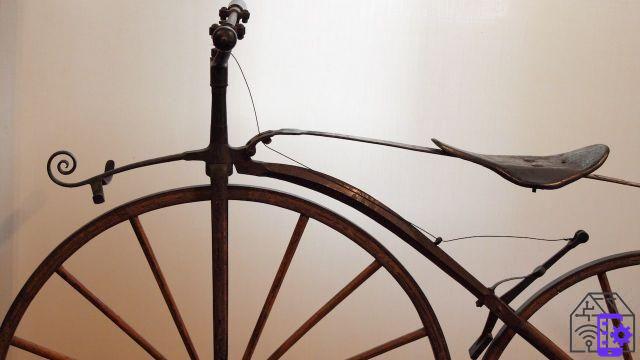
The bicycle: how has it changed over time? Let's take a closer look at the irresistible story of a means of transport that continues to evolve and be loved.
How has the bicycle changed?
Before going into a brief historical excursus, is it really worth stopping to explain what a bicycle is?
It is a vehicle powered by muscle force (or by human propulsion, the most romantic might say). Equipped with a frame and two wheels, it moves forward thanks to a power transmission system generated by the drive wheel.
According to the highway code, the bicycle falls into the category of cycles, along with rickshaws and scooters. The cycles also include electric bikes and scooters, as long as they have a power of less than 500 watts and a speed of no more than 25 kilometers per hour.

The ancestor of the bicycle: the draisine
The ancestor of the bicycle was called draisine. The name is a tribute to its inventor, Baron Karl Von Drais, who on 5 January 1817 patented a sort of proto-bicycle with steering in Baden, Bavaria. The Baron, however, had forgotten to invent pedals.
The origins: the velocipede
As we experiment, finally here is the introduction of the pedals, and with them the appearance of the first velocipedes. While some doubts persist about the year of their appearance, it was decided by convention to… have them born in 1864. There is instead no doubt that for the first time the velocipedes were seen circulating through the streets of Paris.
The origins: the bicycle
A few years later, in 1970, the British James Sturley and William Hillman patented the bicycle. This is the ancient bicycle that we all have in mind: the one with a huge front wheel and an equally significant danger.
The first modern bicycle
The date is 1886, and the gentleman of Coventry we really owe a lot to was called John Kemp Sturley. In fact, he came up with the idea of the safety bicycle: a model of bicycle with a transmission chain on the rear wheel, wheels of the same size, pedals engaged on a gearbox and a front wheel that steers.
Two more years e starting in 1888, with the invention of the tire, the modern bicycle is ready and ready.
How the modern bicycle has changed
Since we can call it a bicycle, the vehicle has remained almost identical in its main components. But it has evolved a lot in materials and in numerous details.
The first epochal transition was that from wood to steel. Until the eighties of the last century, when more resistant and lighter alloys took over, including titanium, carbon and - in recent years - magnesium.
Every other fundamental part of the vehicle, from the braking mechanism to the gearshift system, has undergone such an evolution that an article could be dedicated to each piece.

How the bicycle has changed: the diversification of models
Immediately the object of mass consumption on a planetary level, the bicycle saw the first competitions organized already in the last years of the nineteenth century. The first certified races are older than the bicycles, even if the first real competition of some importance is Liège-Baston-Liège, conceived in 1892. The Tour de France is from 1903 and the Giro d'Italia is from 1909.
This means that racing models began to improve when the bicycle was still a puppy of a vehicle.
Taking a leap forward a few decades, who doesn't remember the lenticular wheels mounted on Moser's bike for the assault on the 1984 hour record?
Not too many years ago, Downhill was invented in California in the late XNUMXs, that is the cycling race on steep slopes. And, as a result, bicycles have been designed that are strong enough to withstand considerable stress.
Thus opened the way for mountain bikes, which appeared in 1978. The rise of the discipline will be unstoppable: just think that the first mountain bike world championships were held only twelve years later, in 1990.
The electric bicycle
And here we are with electric bicycles, or e-bikes, designed to move with agility in urban contexts (but not only: there are also electric mountain bikes).
Although the first attempts to build a pedal assisted bike go back to the end of the nineteenth century, only in recent years have e-bikes experienced an exponential growth.
This is because the electric bicycle marries the ancient charm of the velocipede with two very topical themes: daily mobility in the chaos of cities and ecology.
Discount Bikesofia. Bicycle philosophy
Bikesofia. Bicycle philosophy
- Viola, Andrea (Author)
The myth of the bicycle
And precisely this aspect allows us at least to mention thesocial importance of the bicycle. A practical, economical and ecological vehicle, the bike has entered the collective imagination since it was born and - thanks to its continuous evolution - it seems destined to remain firmly rooted in it.
Il binomial between two wheels and politics, for example, it is compelling if one thinks of the use of bicycles by partisan relays, or of today's use by messengers.
Turning to art, impossible not to mention at least two cinematographic masterpieces, such as Vittorio De Sica's Bicycle Thieves and François Truffaut's Jules et Jim. Or the paintings by Boccioni, or the many songs of the author, from Bartali by Paolo Conte to Il bandito and the champion, written by Luigi Grechi and brought to success by his more famous brother, Francesco de Gregori.
And today? Today, between cycle tourism, bike sharing, cycle paths, government incentives and a renewed attention to the health of the planet and wellness, the bike seems to enjoy a second youth. Which we doubt will ever go down. At best, it will still evolve.


























